Charlottesville To Galax: A Great American Drive
In Part One, we took you to the Smoky Mountains, through a brief history of how the Blue Ridge Parkway evolved, over spectacular vistas and the mountain-hugging Linn Cove Viaduct, and to great campgrounds found along the Parkway’s southern half.
Now it’s time to approach the Parkway from the north end near Charlottesville, Virginia, on another Great American Drive. You’ll be within sight of where America’s third president lived after leaving Washington (more on that in an upcoming post), and you’ll meander south to link two towns claiming to be among the birthplaces of country music.
On the way, take in some great side trips, including a town that inspired a TV show, a historic mill, a winery that brings a hint of Tuscany to this part of the Piedmont, and more of those incomparable Blue Ridge views and campgrounds.
While the southern half is all about great mountain vistas rising upwards of 6,000 feet, the northern route begins as more genteel, nearly within view of the homes of three presidents, and the university one of them founded.
We began the northern leg of our Blue Ridge tour just east of Charlottesville after visiting Monticello, the home of Thomas Jefferson, in the “Ridge” portion of the Parkway.

Early on, we met a couple determined to do the entire Parkway in one day – all 469 miles. I guarantee you, this is not that kind of a drive. This is a drive to savor every mile; to pause and reflect on what you’re seeing and thank the wise planners who singled out this route for all to enjoy, starting during the depths of the Depression in the 1930s. It would be another 40 years before completion.
As you look over the beautiful scenery, slow down and imagine what life was like here before farms and roads, when wisps of smoke wafting from welcoming inns or the lowing of livestock echoing across a split-rail-fenced farmstead – cut out of what was then the world’s largest continuous deciduous forest – were perhaps the only signals that you, the traveler, weren’t alone.
It’s to be enjoyed at an appropriately leisurely pace as we did in our Leisure Unity Murphy Bed, Lucky Us, setting aside a five-day trip just to take in this northern portion. You can do it in three or four – don’t do it in a day. Please.
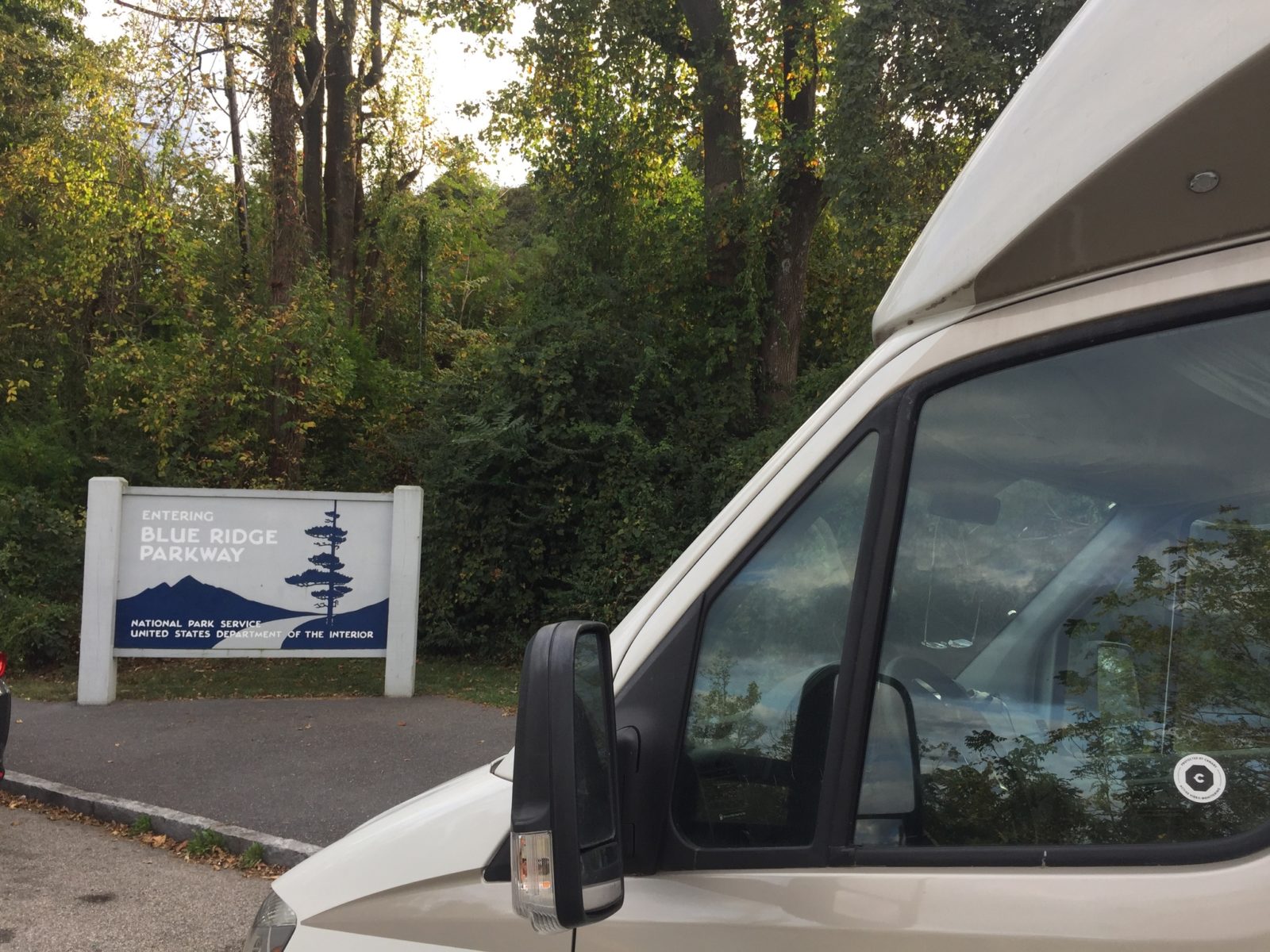
Our northern Parkway drive began at the end of another scenic road trip: the Shenandoah National Park’s Skyline Drive, which flows into the Blue Ridge Parkway’s (BRP) Milepost 0 at Rockfish Gap. This natural geographic low point once saw bison herds rumble through, Native American hunters and camps, and at least one Thomas Jefferson visit, when he met with others to decide on a location for the now-nearby University of Virginia. It’s a planned low-key entrance to the road, just a cloverleaf turn off I-64 and an unassuming sign to announce we were once again on one of America’s great, and historic, roads.
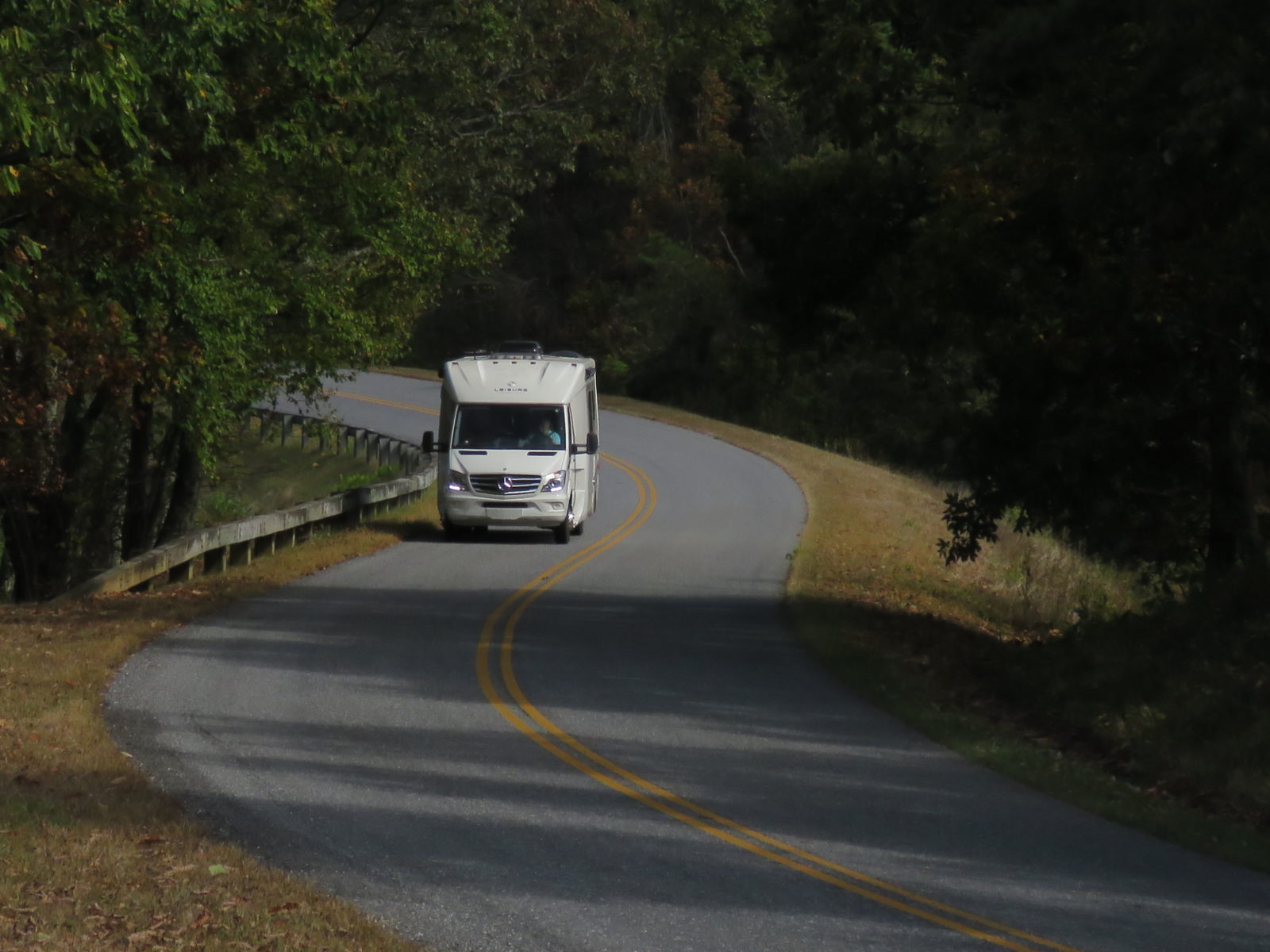
Barely a mile in we were enveloped in the forest that the BRP is famous for, and we quickly stopped at the first of hundreds of scenic turnouts that will make anyone regret doing this drive in a day. We planned on covering maybe 100 miles a day and camping either at sites along the route or in a nearby state or national forest campgrounds, which is what we did on our first overnight.

That first overnight was at Sherando Lake Recreation Area, a short drive from the Parkway into the valley below inside George Washington and Jefferson National Forests. With help from a fellow camper who said there was one hard-to-spot site left, we made a second trip through to finally back into the last open site in the campground’s three loops. (We could have tried the non-electric loop, too.) Our site had power and water and was just a few steps from the bathroom and showers. In October – pre-fall colors touring – it was surprising to see the entire campground booked, especially since we had checked about a week before we left and there were plenty of sites open. But it’s a pretty spot in the valley and next to a lake. Next time we’d make a reservation.
We drove back up the hill the next morning and rejoined our southerly course on the Blue Ridge, pulling off whenever we wished to once again gaze over the hills through the bluish haze that gives the area its name. The longest linear national park with free access stretched before us.
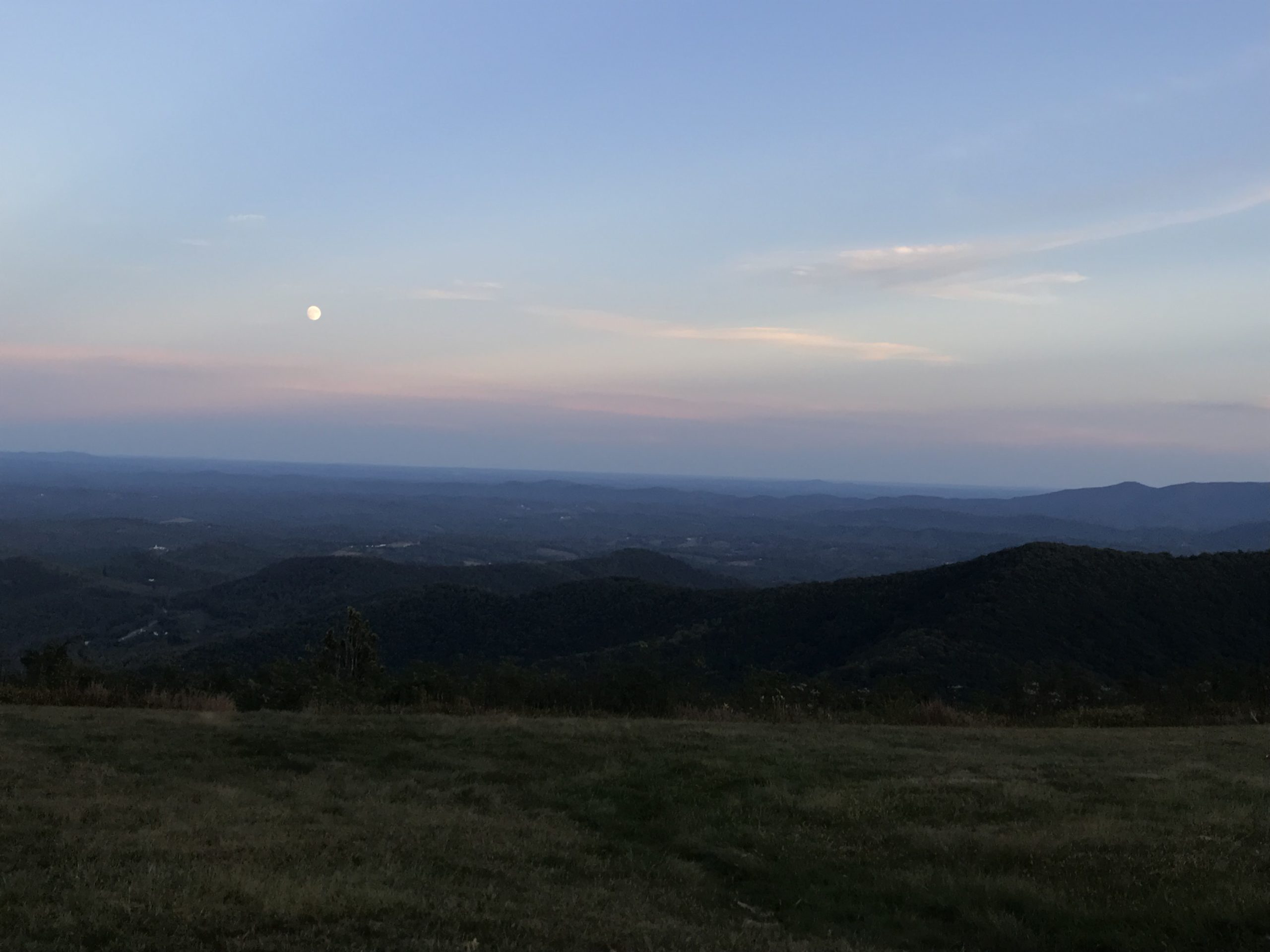
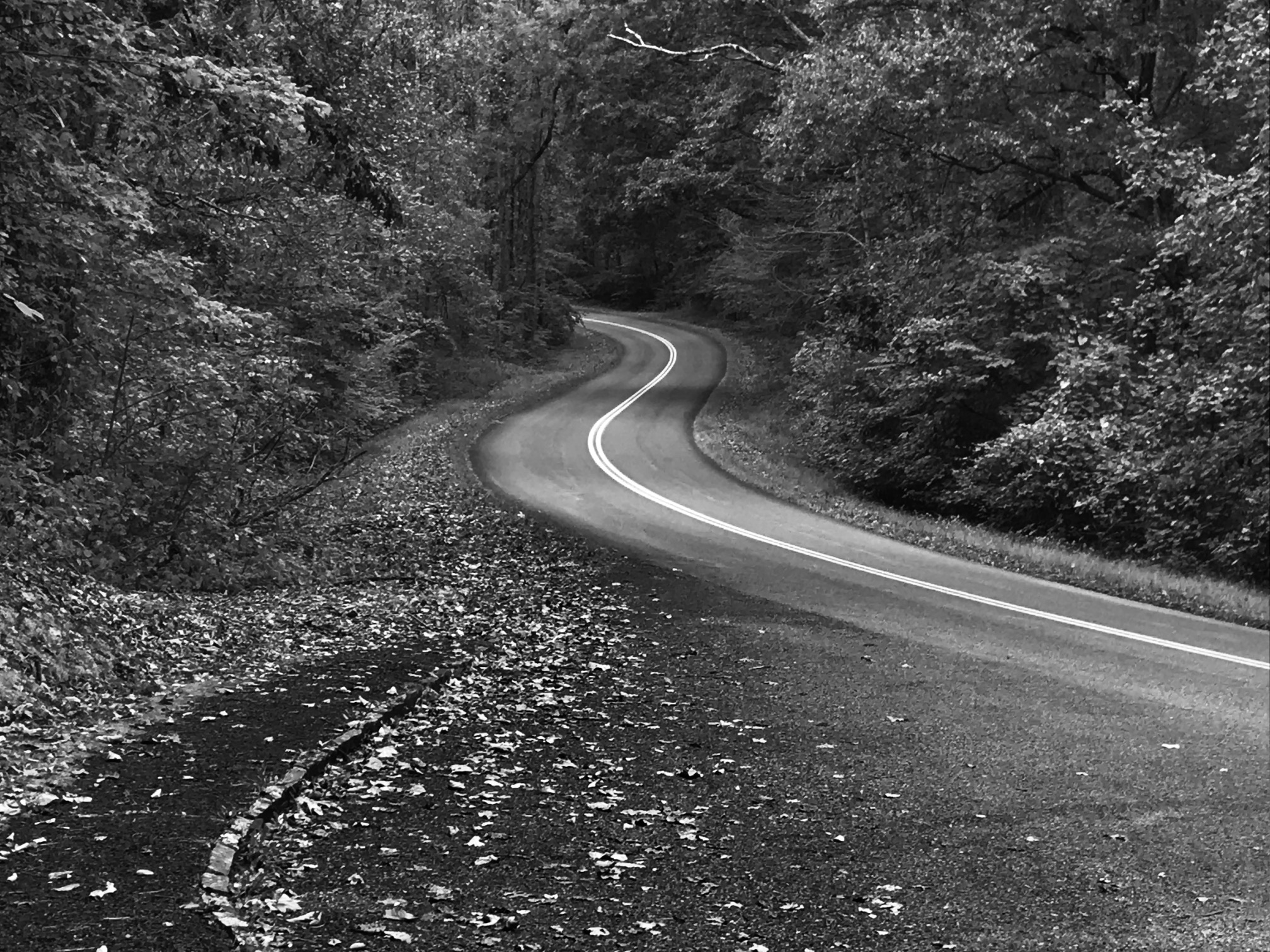
Highlights Found on the Parkway’s Northern Loop
After more of those views around every corner and overlook pull-off, we wound up our second day at Mile Post 86 (yup, 86 miles, ALL that way!) in Peaks of Otter Campground. This campground has 140 terraced campsites on a heavily treed hill, some flatter and more amenable to our 2015.5 Unity than others. With our discount national park senior pass, our non-electric site cost us just $10.
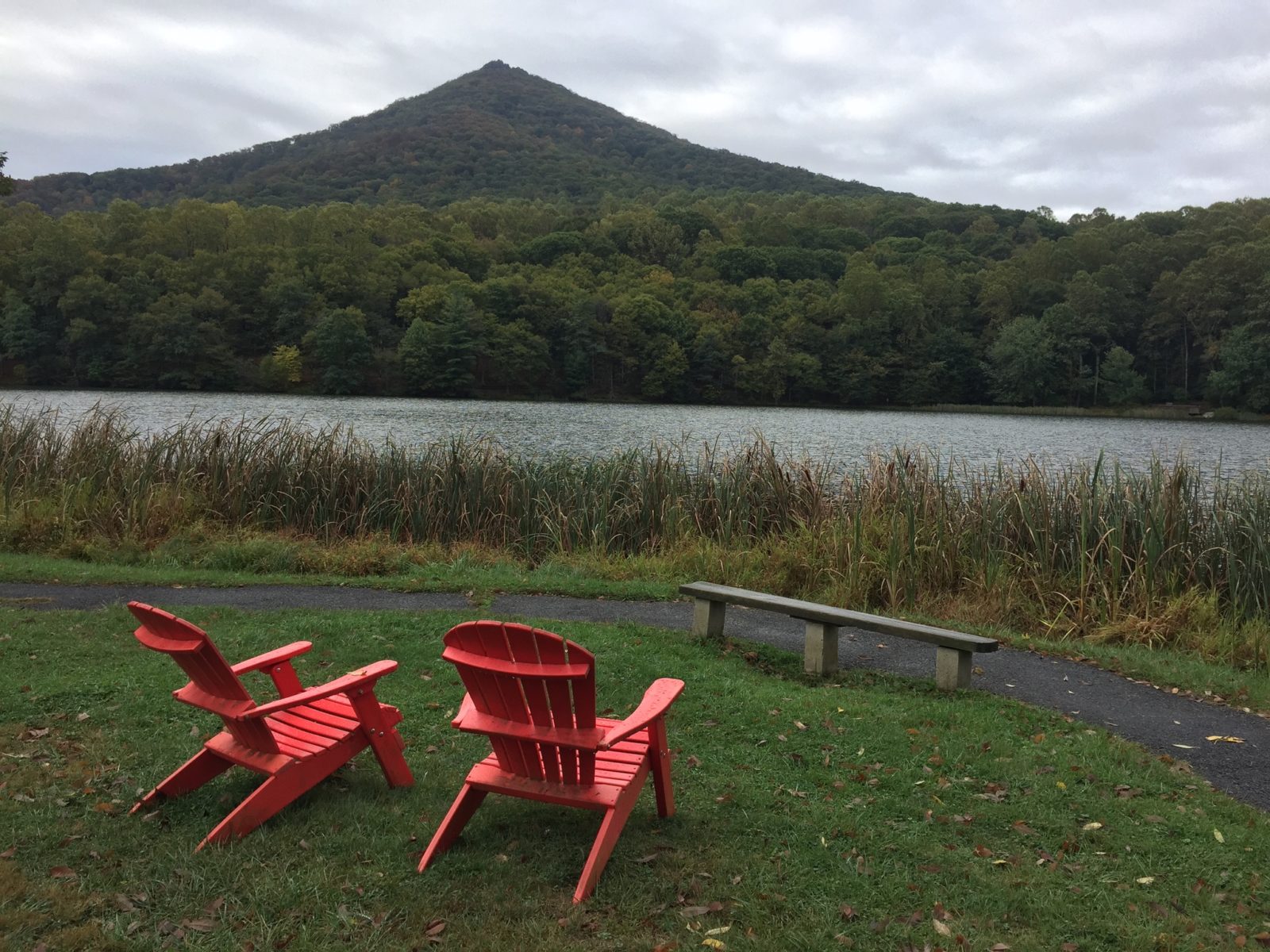
The next morning, we headed for a leisurely breakfast at the inn and lodge along manmade Abbott Lake. Because of the weather, we didn’t walk the foot trail to the peaks, which was shrouded in clouds. The origins of Peaks of Otter’s name are also cloudy; they were either so-named by local Cherokee, or by two Scottish immigrants or because a nearby river had otters. Choose one.
The three main peaks can be climbed, or there’s a shuttle that runs to the top of one if you’re not a trekker.
Rocky Knob
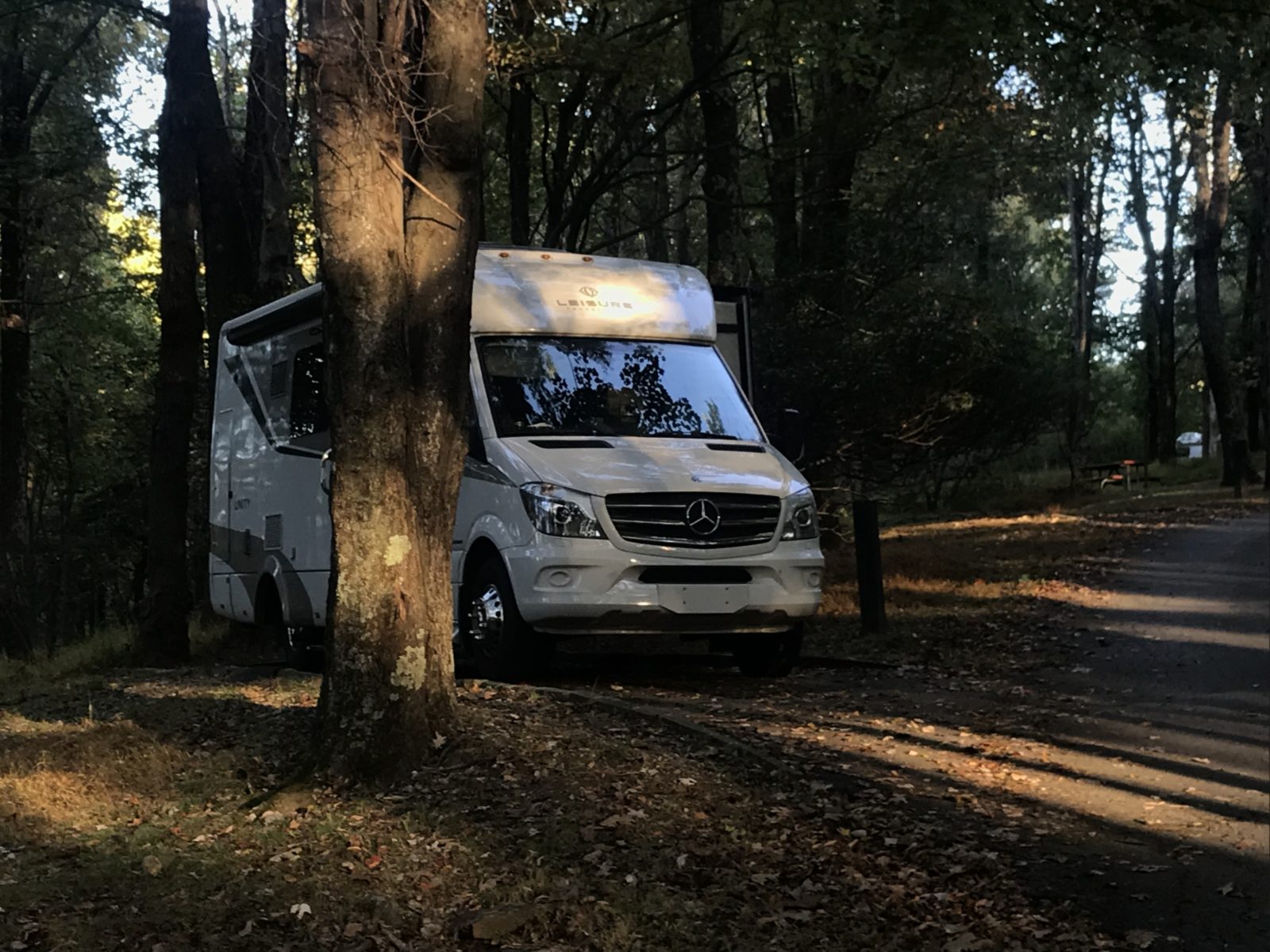
Rocky Knob is a great, treed campground at about Mile Post 170 (yup, all of another 84 miles that day!) that features engaging scenery along with many other attractions that will make you want to park your LTV here for a few days.
Why?
“I’ll tell ya, friends and neighbors,” as a comedian and then TV star Andy Griffith used to say. Why’d I brought Sheriff Andy into this? I’ll connect those dots in a bit.
First, the campground itself provides access to some either pretty rugged or pretty easy hikes, depending on which way you turn at the fence line across the BRP from the campground entrance.
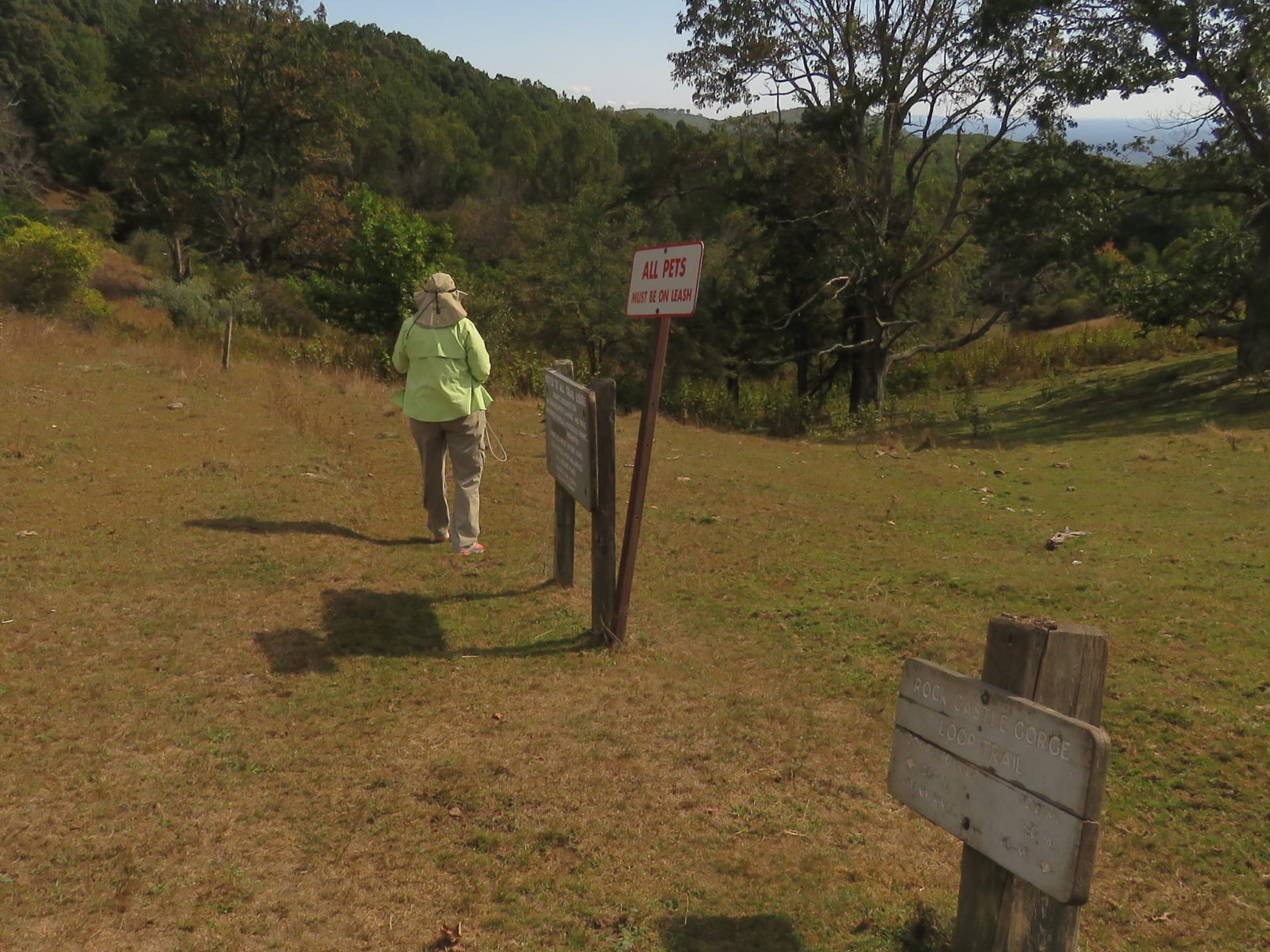
We first mistakenly took the low road to the left, and after walking past remnants of old mountain homesteads, hiking along ridge trails, and shimmying down and up some interesting rock faces for 2.5 miles approaching Rock Castle Gorge, we decided to go no further on what we later found was a 10.8-mile loop. Our trek did include carefully walking past an active yellow jacket nest that someone before us had graciously left a sign on the trail about. The route left is great, leading past remnants of old farms and cabins as you descend into the valley, but about three miles in you’ll also encounter descents like these, which is about where we said, “let’s turn back.”
We returned to the access point the next day, turned right instead of left (as originally directed), and enjoyed a shorter walk past resting cattle, alongside a local inhabitant, and to an overlook.
Later, we drove back to that overlook to stop in at Chateau Morrisette. After a visit to the tasting room, we walked to the restaurant for an evening snack – both solid and liquid – while taking in another BRP-style view. Along with some decent whites, you can enjoy outdoor dining on the restaurant terrace looking over the valleys, with views that, for some, will be reminiscent of Tuscany.
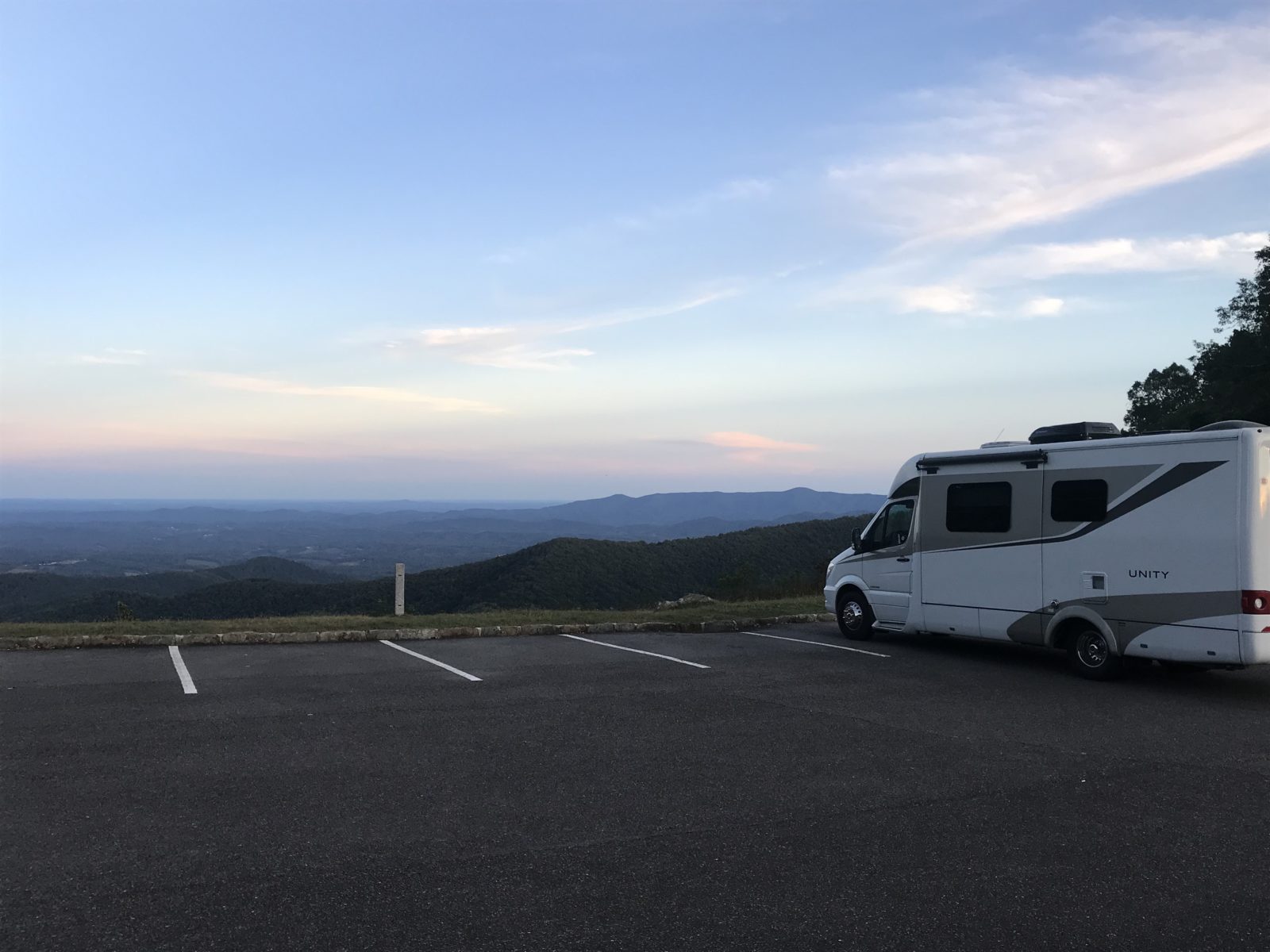
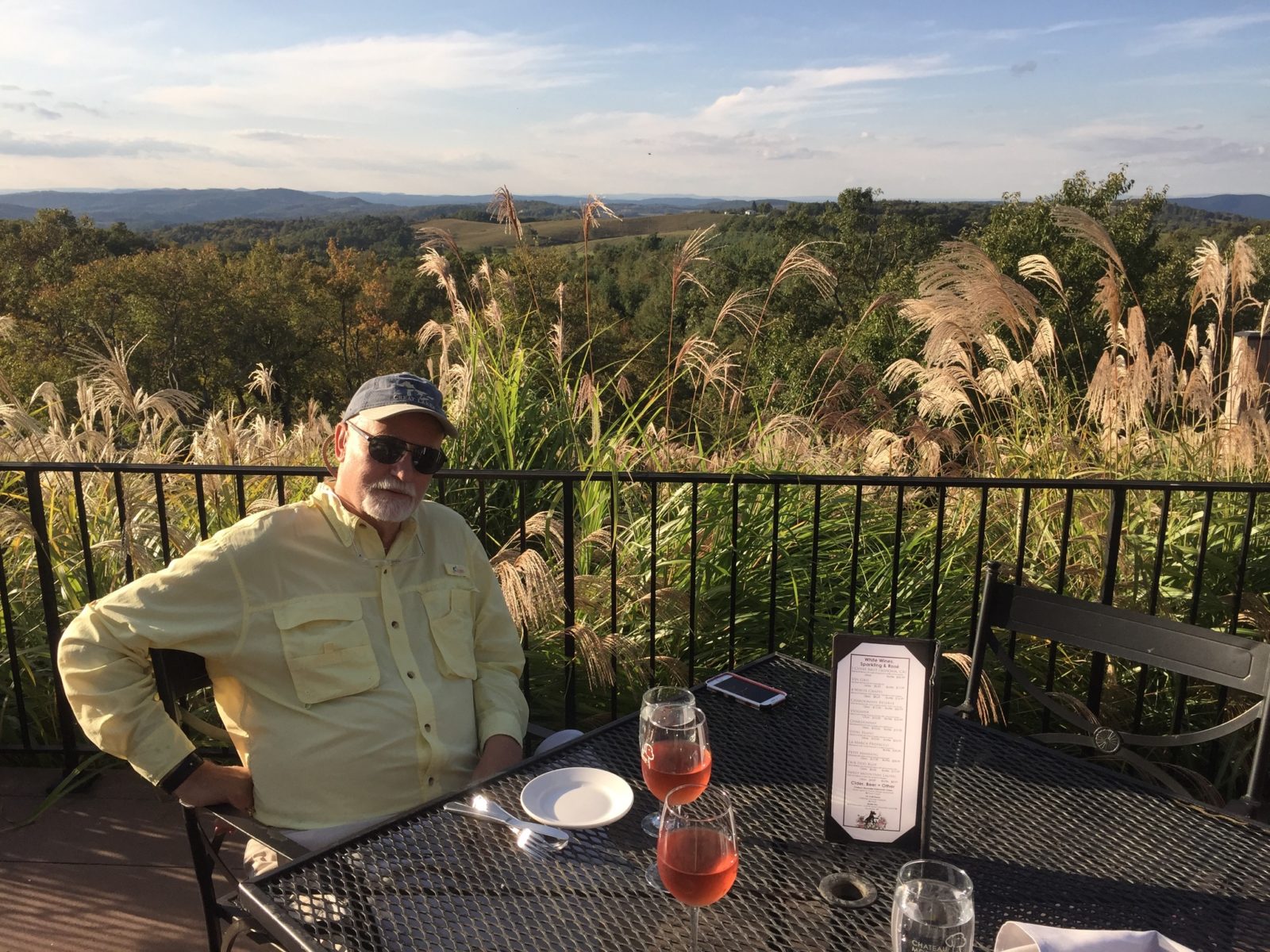
Mabry Mill
About five more miles down the road is Mabry Mill. The mill’s reflection on the millpond is so picturesque, it’s one of the most photographed spots in the country.
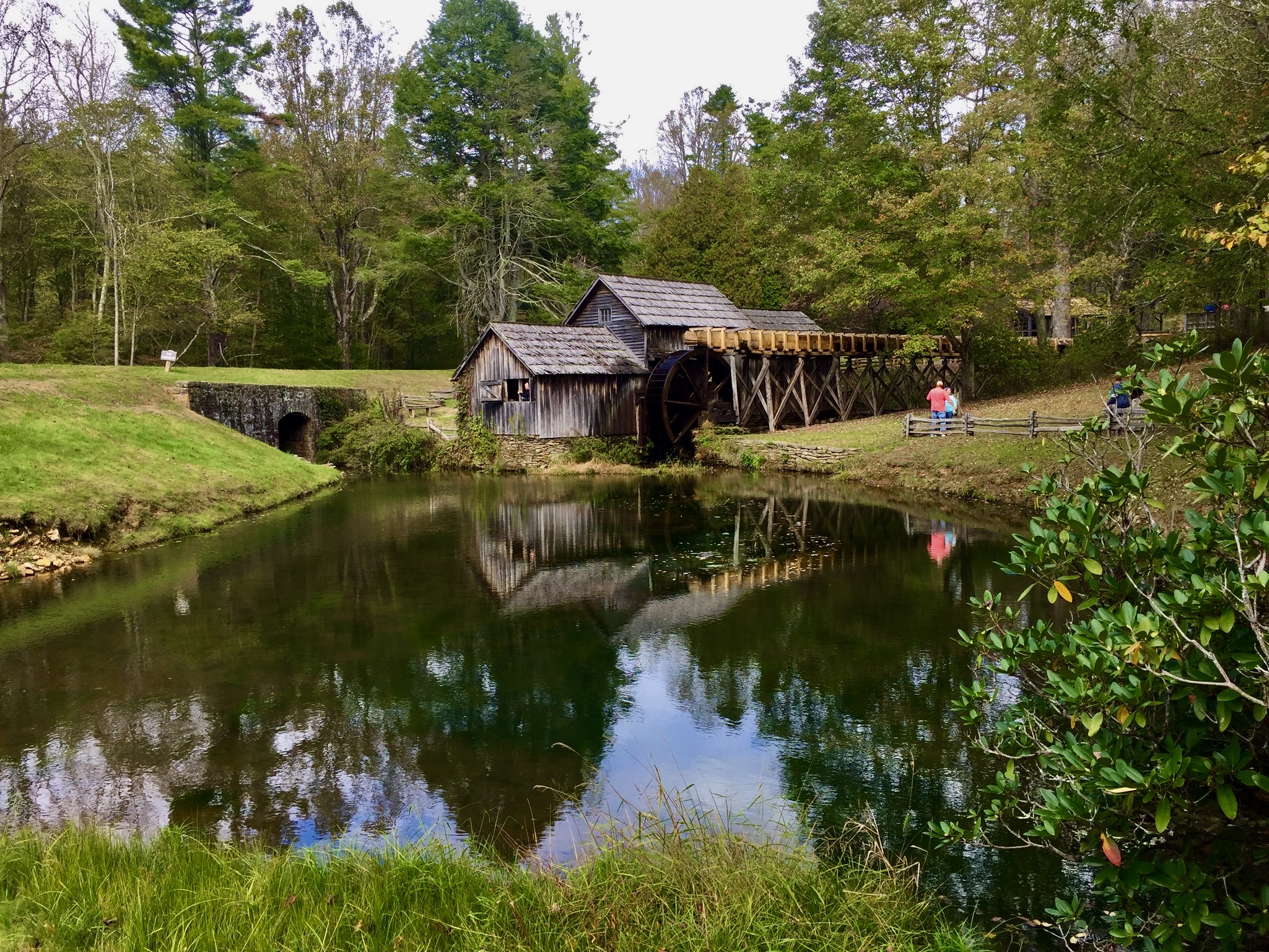
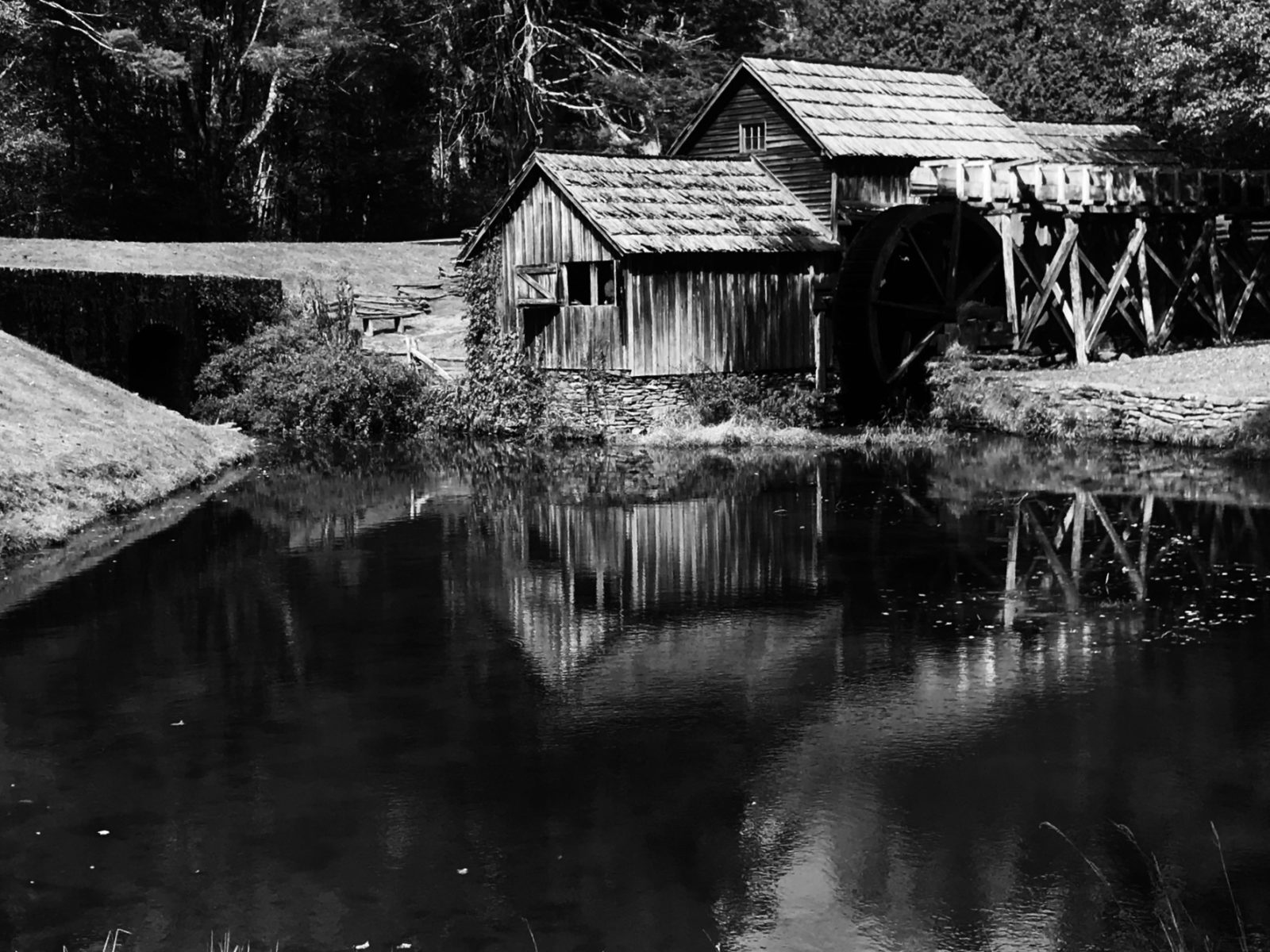
A heavily visited attraction on weekends, the Mill has been here since 1903. It first operated as a gristmill and later expanded to sawing lumber and lathing wagon parts. You can still pick up packets of ground cornmeal, flour, and even buckwheat here, and can also enjoy a meal at its small restaurant.

Walk the grounds to follow the millrace. In season, costumed interpreters work the blacksmith shop and provide more glimpses into mountain life here in the early 20th century.
Floyd and Mount Airy
Rocky Knob Campground is only about 13 miles from Floyd, Viriginia, which can rightly claim to be one of the region’s top artisan towns and is a stop on the Floyd County Artisan Trail. Part hippie town (former and current) and part music center, it’s also home to the Friday Night Jamboree at the Floyd Country Store.
You can take a drumming lesson from Kasey “Caveman” Jones, hop from store to store, and enjoy this funky little village on a walkabout. Floyd is also a stop on Virginia’s Crooked Road, taking you to many places that highlight the origins of old-timey and modern country music.
Now, mentioning the name “Floyd” hereabouts also evokes memories of another Floyd – namely, Floyd the Barber, made famous in the Andy Griffith Show, which by Griffith’s telling is set in Mayberry but is patterned after his hometown of Mount Airy, about 42 miles from Rocky Knob via the Blue Ridge, at Milepost 199.5.
Drive into Mount Airy and you’ll find it’s about as Mayberry as the local Chamber of Commerce could make it. In fact, click on the link above, and it’ll take you to visitmayberry.com. Tour the sights in Mayberry in a replica of Barney’s patrol car. See Andy and Aunt Bea’s home, and get trimmed at Floyd’s City Barber Shop, right next door to The Snappy Lunch. And if you wish, stay at Pilot Mountain State Park or, as the show called it, Mount Pilot. It’s all great fun.
Back To Galax
This was one of our favorite stops on our south-to-north tour, so we just had to return. There are at least three private campgrounds in the area, and we chose Cool Breeze, which offers a country setting replete with cattle in the nearby rolling hills, and annual music events, too.
Then we drove downtown to re-discover the Galax Smokehouse (we also could have tried Aunt Bea’s Barbecue), a great place for a relaxed lunch or dinner in town.
The Smoke on the Mountain Barbecue Championship this year is in mid-July (check for updates due to COVID-19), and while you’re there, check out what’s on at the Rex Theater or stop at the Visitor’s Center for festival information. Then, head to Blue Ridge Music Center for free afternoon performances, always by a local artist. When we visited this time, banjo player Butch Robins (who in the past played with “Father of Bluegrass” Bill Monroe and the Bluegrass Boys) and New Grass Revival (who I saw decades ago in Utah) entertained.
Next time, we’ll try to time our visit for a larger concert at the amphitheater. For now, this was a great way to end this part of our Blue Ridge Tour, and now, perhaps, for you to begin your own.
When You Go
- Follow the links included to all our highlights, and be sure to read Atop The Blue Ridge: Part I.
- For more information on Galax and events in town, contact the Galax Visitor Center.
- Please use this link for information on BRP closures due to COVID-19.
- Find more information on the BRP here.


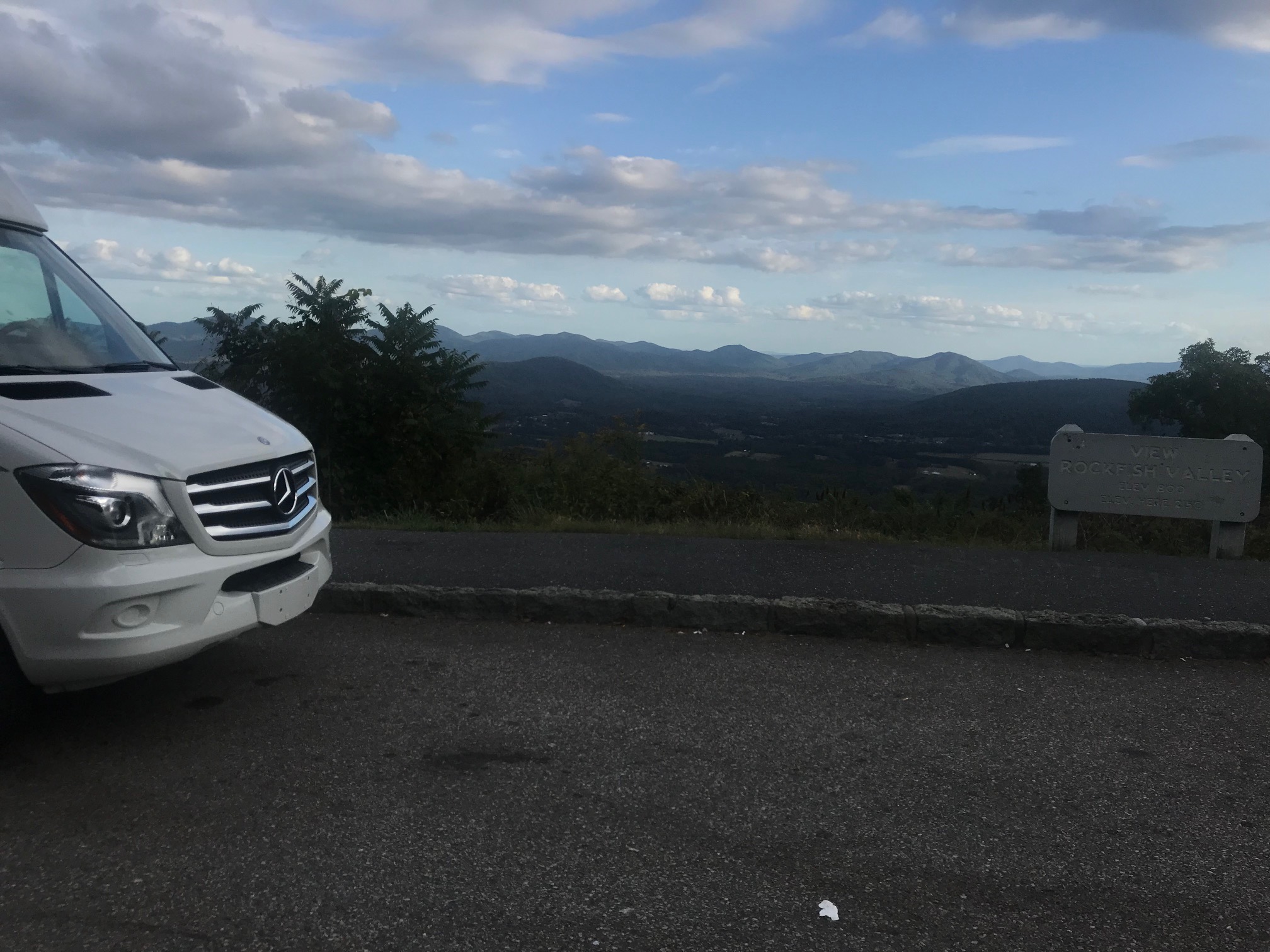
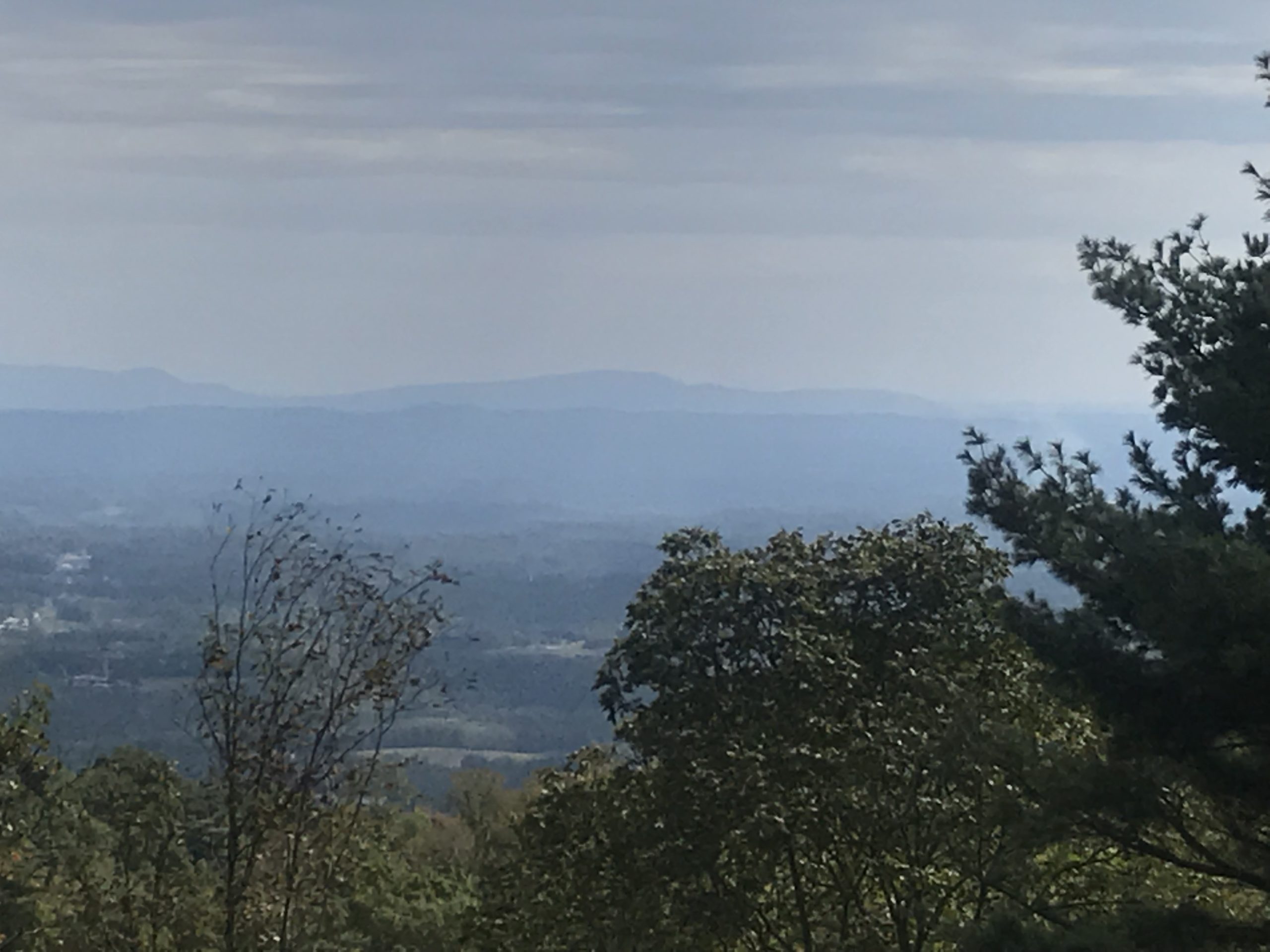

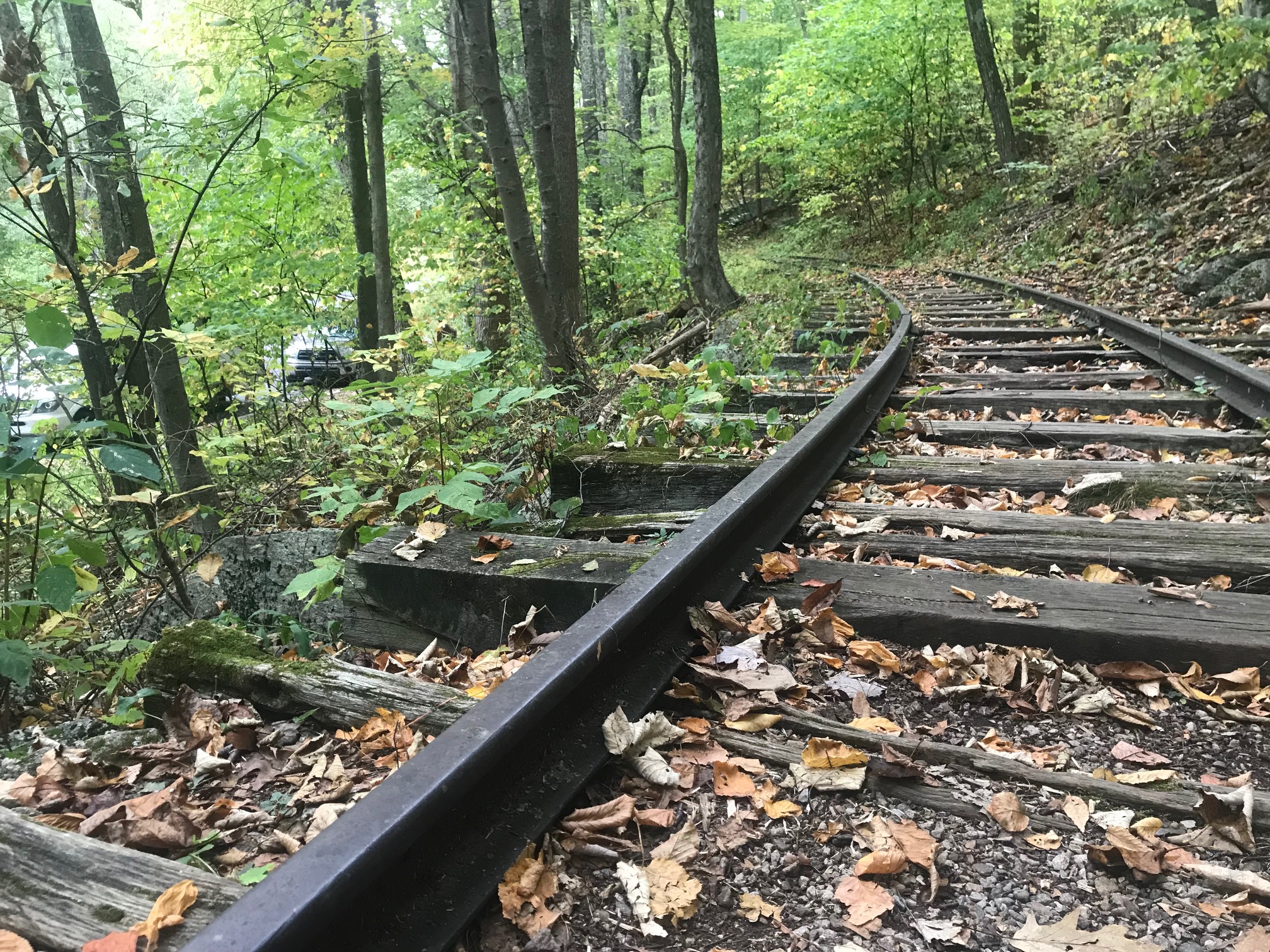
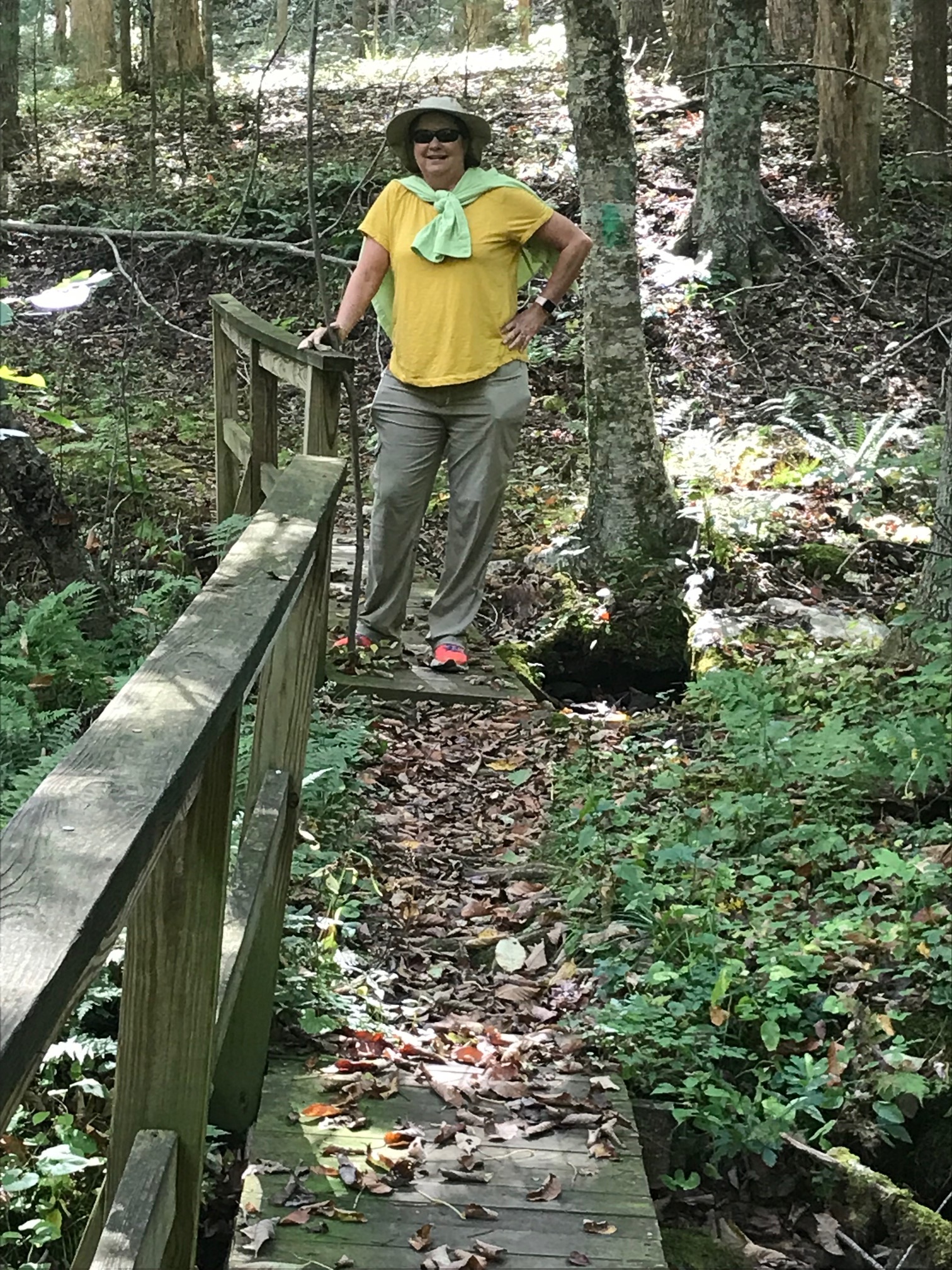
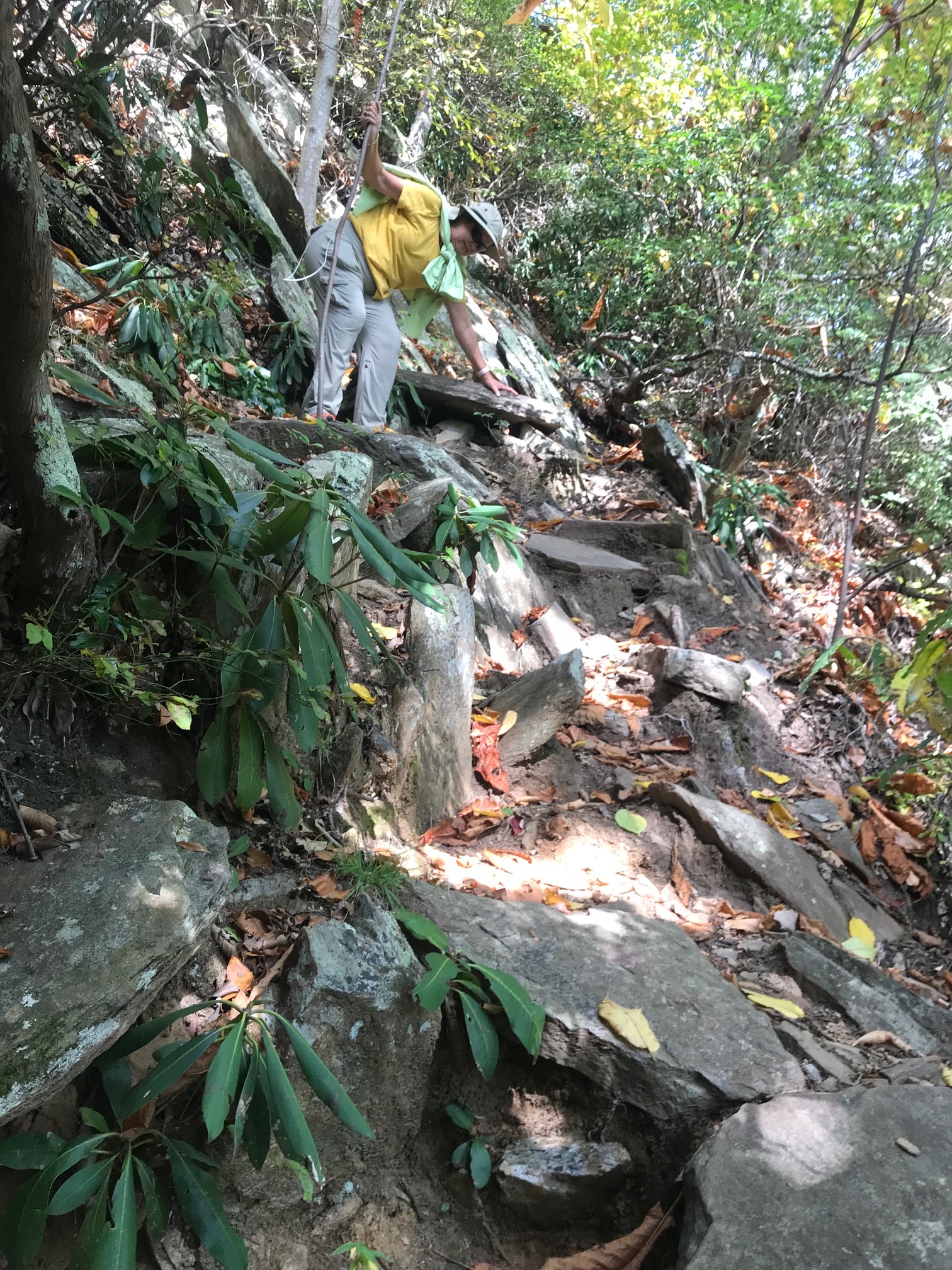
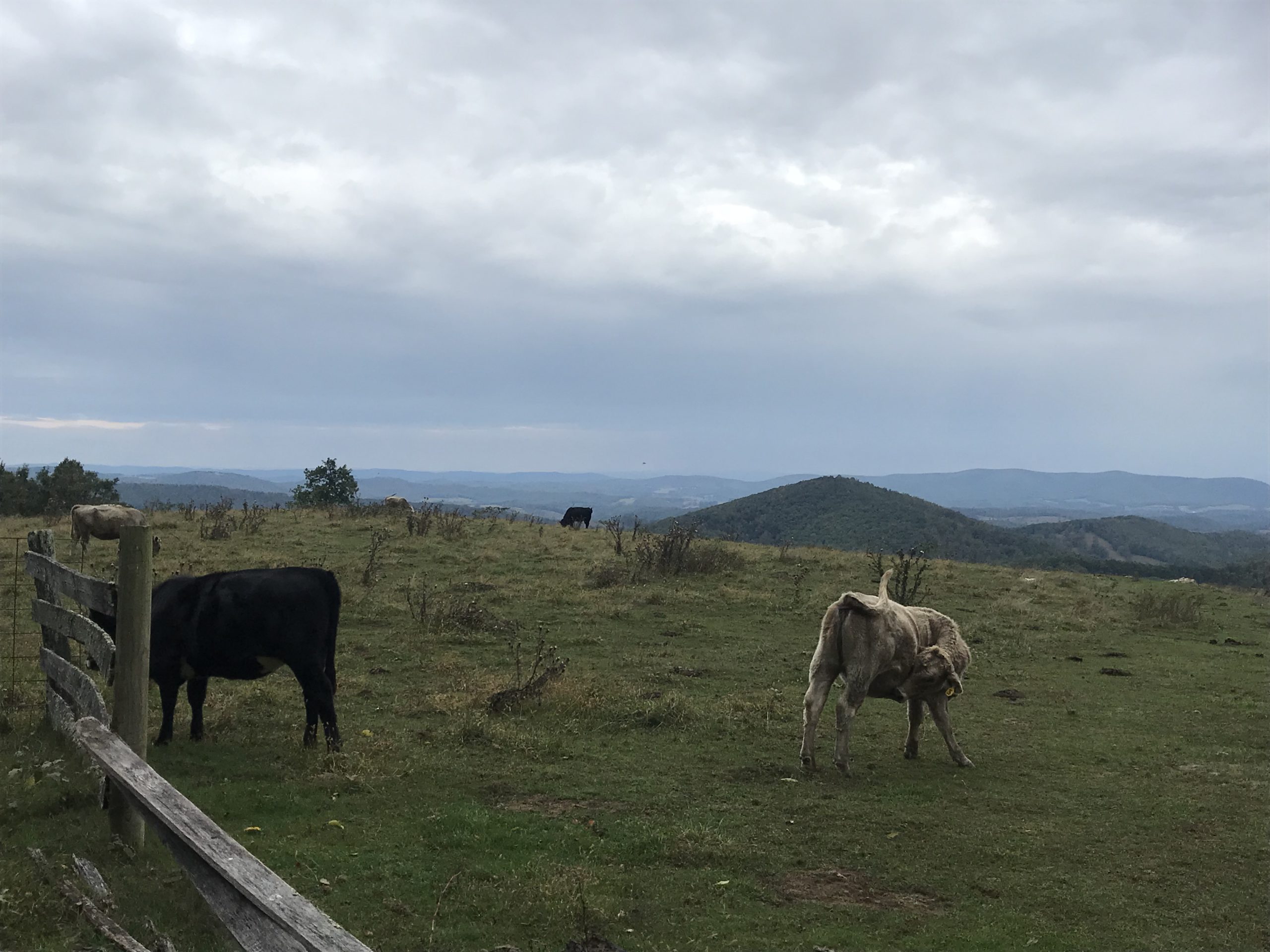
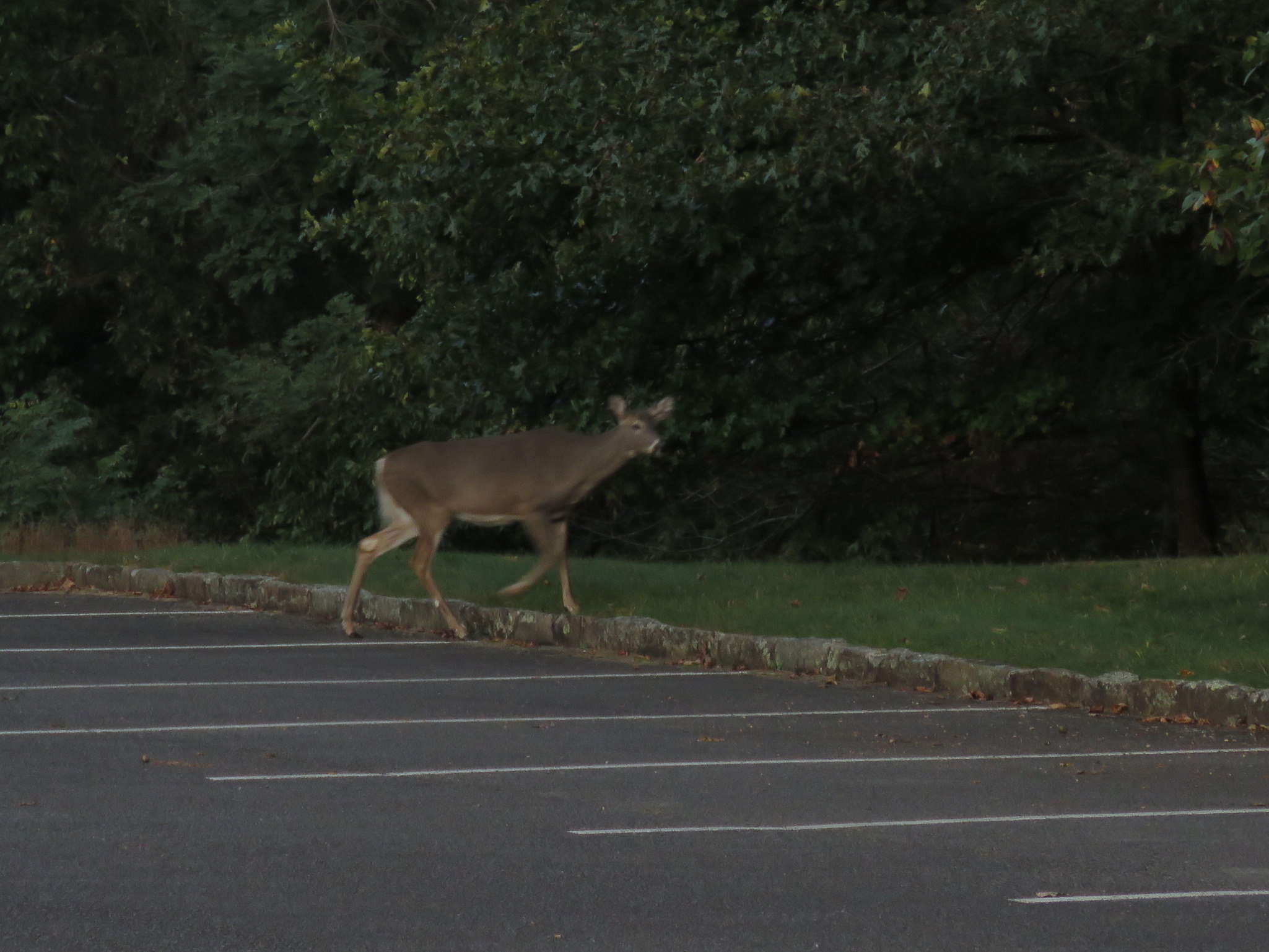
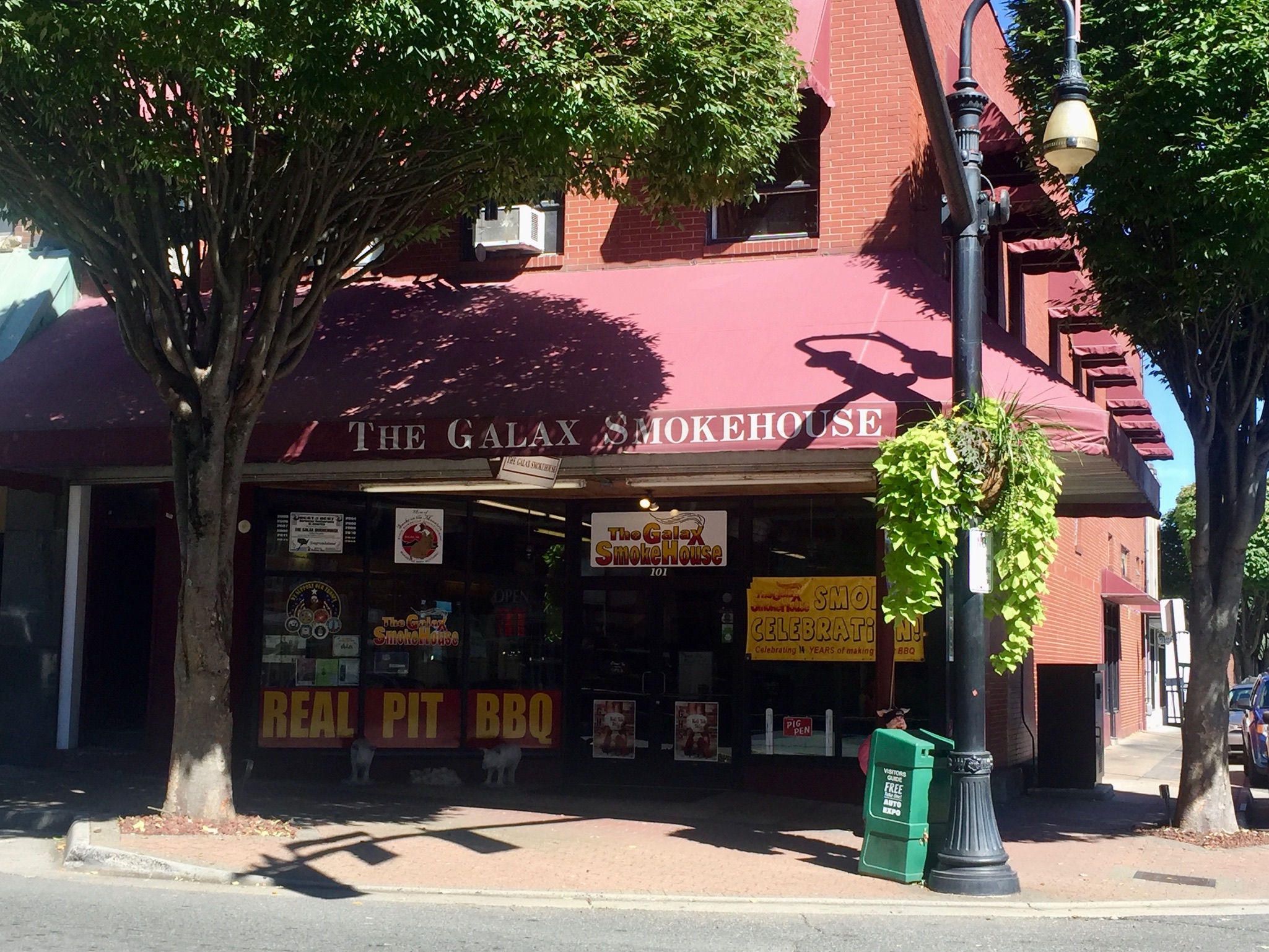
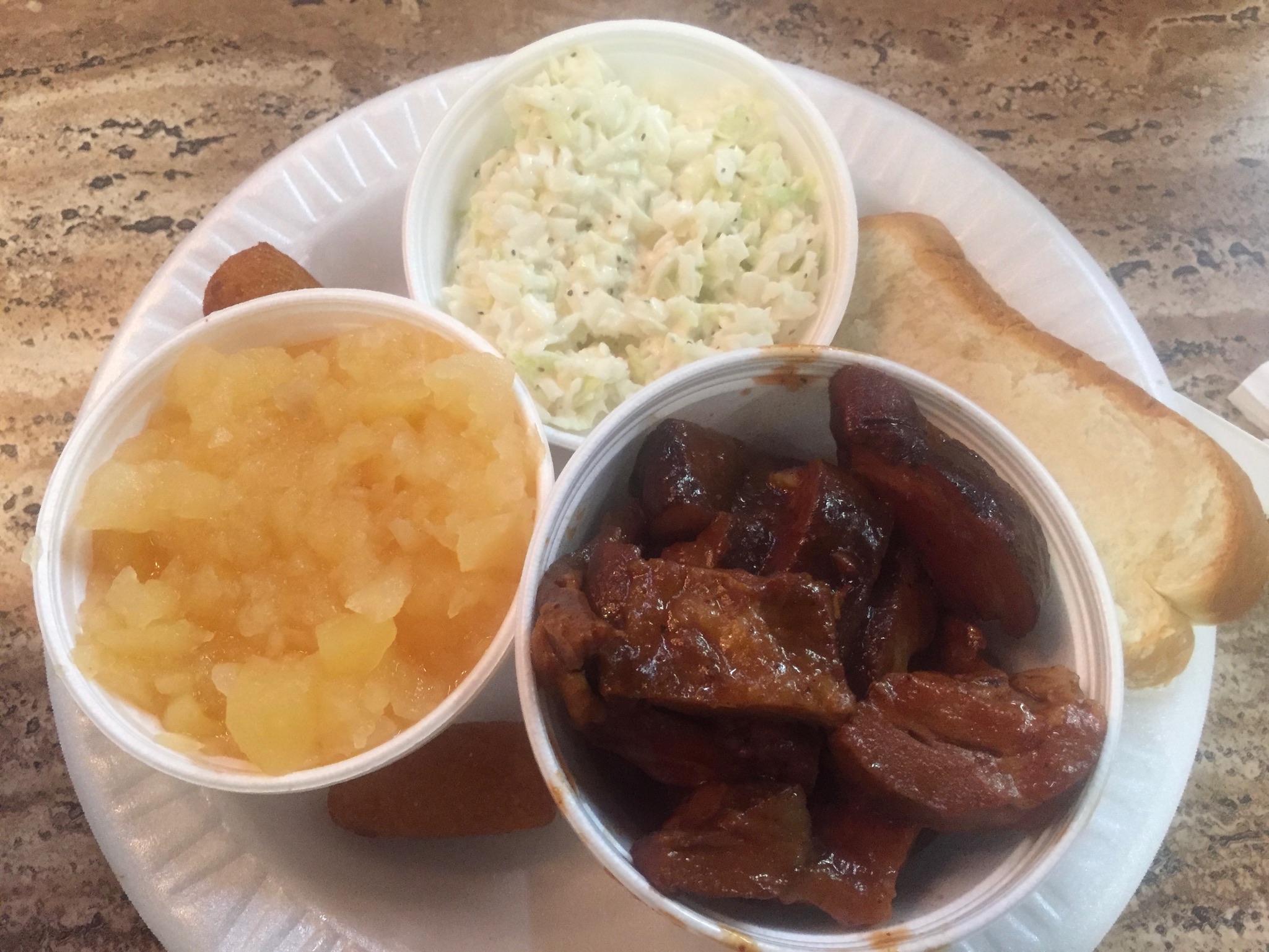



Comments